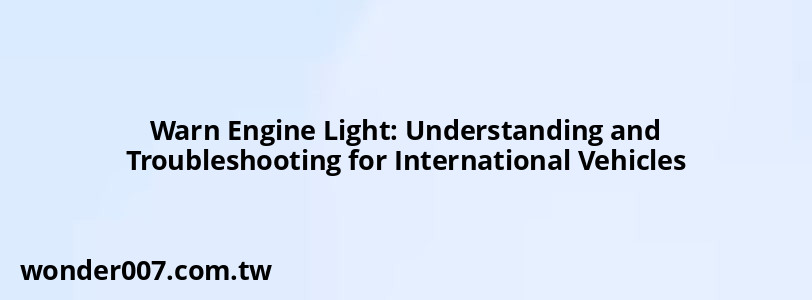Warn Engine Light: Understanding and Troubleshooting for International Vehicles

The "Warn Engine" light on International vehicles is a critical indicator that signals potential issues with the engine. This article aims to provide essential information for vehicle owners and operators regarding the causes, implications, and troubleshooting steps related to this warning light.
What Does the Warn Engine Light Indicate?
The Warn Engine light typically appears as an amber triangle or a message on the dashboard. It serves as a warning that the engine management system has detected a fault. This could range from minor issues, such as a loose gas cap, to more serious concerns like engine overheating or low oil pressure.
Common Causes of the Warn Engine Light
- Faulty Sensors: Problems with sensors, such as the Diesel Particulate Filter (DPF) pressure sensor, can trigger the warning light.
- Oil Dilution: Diesel fuel contamination in the engine oil can lead to this warning, affecting engine performance.
- Electrical Issues: Short circuits or faulty connections in the vehicle's wiring can cause intermittent warnings.
- Engine Overheating: If the engine coolant temperature exceeds safe limits, it will activate the warn engine indicator.
Troubleshooting Steps
When the Warn Engine light activates, it is crucial to take appropriate actions:
1. Check for Codes: Use an OBD-II scanner to retrieve diagnostic trouble codes (DTCs). This will help identify specific issues triggering the warning light.
2. Inspect Fluid Levels: Ensure that oil, coolant, and other essential fluids are at appropriate levels. Low levels can cause overheating or inadequate lubrication.
3. Examine Electrical Connections: Check for loose or corroded connections, particularly around critical sensors and modules.
4. Consult a Mechanic: If basic checks do not resolve the issue, consult a qualified mechanic who can perform more detailed diagnostics.
Importance of Addressing the Warn Engine Light
Ignoring the Warn Engine light can lead to severe engine damage and costly repairs. Immediate attention is necessary to prevent further complications.
FAQs About the Warn Engine Light
FAQs About Warn Engine Light
- What should I do if my Warn Engine light comes on?
Check your vehicle’s fluid levels and use an OBD-II scanner to read any diagnostic codes. - Can I continue driving with the Warn Engine light on?
It is advisable to pull over and investigate the issue as continuing to drive may cause further damage. - What does it mean if the Warn Engine light is flashing?
A flashing light typically indicates a more severe issue that requires immediate attention.
In summary, understanding what the Warn Engine light signifies and how to respond effectively is essential for maintaining your International vehicle's performance and longevity. Always prioritize safety by addressing any warning lights promptly.
Related Posts
-
Kia Forte Backup Camera Troubleshooting Guide
30-01-2025 • 244 views -
Ford F150 4WD Not Engaging: Troubleshooting Guide
30-01-2025 • 299 views -
Toyota RAV4: Troubleshooting Whining Noise When Accelerating
30-01-2025 • 225 views -
Kia Sorento: Understanding Oil Filter Housing Leaks
28-01-2025 • 266 views -
Hyundai Santa Fe: Troubleshooting Turn Signal Issues
29-01-2025 • 238 views
Latest Posts
-
Power Steering Fluid Leak On Passenger Side
01-02-2025 • 466 views -
How To Turn Off Paddle Shifters Mercedes
01-02-2025 • 391 views -
2015 Chevy Traverse AC Recharge Port Location
01-02-2025 • 422 views -
Rear Brake Caliper Piston Won't Compress
01-02-2025 • 363 views -
Are O2 Sensors Covered Under Warranty
01-02-2025 • 381 views
Popular Posts
-
Hino Warning Lights: Understanding Dashboard Alerts
26-01-2025 • 814 views -
EPC Light: Understanding Causes and Solutions
26-01-2025 • 1072 views -
Power Steering and ABS Light On: Causes and Solutions
27-01-2025 • 652 views -
Toyota Hiace: Fuel Efficiency Insights for 2025
26-01-2025 • 669 views -
V12 Engine Costs: What You Need to Know
26-01-2025 • 695 views
